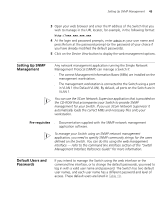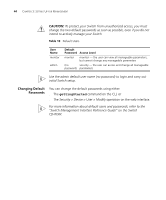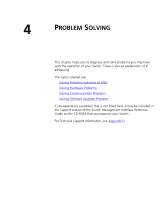3Com 3C17400 User Manual - Page 47
Solving Hardware Problems, A link is connected and yet the Status LED for the port does not, light - pdf
 |
View all 3Com 3C17400 manuals
Add to My Manuals
Save this manual to your list of manuals |
Page 47 highlights
Solving Hardware Problems 47 A link is connected and yet the Status LED for the port does not light Check that: ■ The Switch and the device at the other end of the link (or cable) are connected securely. ■ The devices at both ends of the link are powered-up. ■ The quality of cable is satisfactory. ■ Auto-negotiation settings are the same at both ends. Auto-negotiation problems will occur with 10BASE-T, 100BASE-TX or 1000BASE-T where auto-negotiation is disabled and incorrect cables are being used (cross-over or straight). Auto-negotiation problems will occur with fiber if: ■ The Receiver (RX) and Transceiver (TX) cable connectors are swapped. ■ Fibers are broken. ■ Auto-negotiation differs at either end (a link appears at the 'fixed' end and not at the auto-negotiation end). Solving Hardware Problems In the rare event of your Switch unit experiencing a hardware failure, refer to the list of suggested solutions below. A fan failure warning message is received Your Switch has a fan monitoring system that will generate fan failure warning messages. Fan failure could potentially reduce the lifetime of the Switch. The monitoring system polls the fan status at periodic intervals while the unit is powered up. If one fan has failed in the Switch, a warning message will be generated in the following way: ■ RMON Trap - If configured, an RMON trap is generated and sent to the management workstation. For further information about RMON, refer to "Chapter 7: Status Monitoring and Statistics" in the Switch Implementation Guide supplied in PDF format on the CD-ROM that accompanies the Switch.















